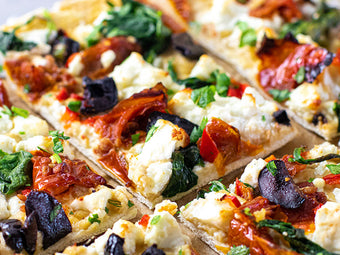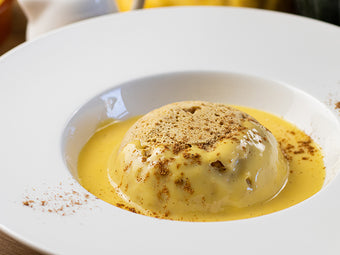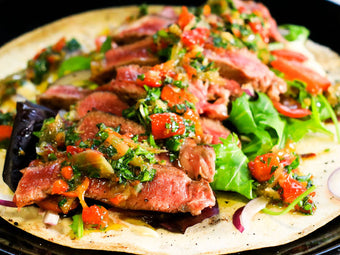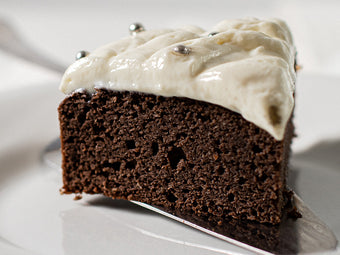How To Avoid A Dry Christmas Turkey
Here's our ultimate guide to avoiding dry roast turkey! Serve with Lo-Dough sides or as leftovers to keep things high-taste and low-calorie this Christmas.
Christmas is just around the corner and we're giving you the festive low-down - the fool-proof guide to roasting a turkey and serving perfect gravy.
Pre-cooking advice
Before we get to actually cooking your turkey, here are a few tips to ensure things go smoothly on the big day.
First of all, buy the best quality turkey you can afford - this will make a difference to the flavour of the finished roast. It goes without saying, be sure the bird you buy will actually fit in your oven! Many people have been caught out by a large turkey during Christmases gone by! We've gone with a 4kg turkey which is generous, without being excessive and will feed 6-8 with leftovers! If cooking for 2-4, it might be best cooking a large chicken, served with all the usual Christmas sides, you won’t feel short changed.
Next, where possible, buy from a butcher (or butcher's counter at your supermarket) and ask for the giblets to be included. You may even wish to buy a few chicken wings extra to this (they are super cheap). These come in very useful for adding depth and flavour to your gravy and also can be used as a trivet to keep your turkey raised in the roasting pan.
Oven temperatures vary quite dramatically, with many domestic ovens being significantly less hot than they suggest. If you know the quirks of your own oven, then be aware of this, but otherwise, we recommend buying an oven thermometer to ensure perfect cooking.
Finally, make sure to take the bird out of the fridge an hour or two in advance of cooking. If taking your turkey out of the freezer, defrost in your fridge 48 hours in advance and take out of the fridge before cooking, as above.

Prepping your turkey (and gluten free stuffing)
As mentioned above, your 4kg turkey which will easily feed a family of four and leave plenty of turkey for leftovers... great in salads, wraps, pies and curries (try serving with our Lo-Dough bhajis) over the next few days. We'll keep our roasting method as simple as possible, while offering maximum flavour. In the bottom of a deep sided roasting tray lay your giblets and any chicken wings you have bought. Add a halved carrot, onion, piece of celery, a head of garlic, a few sprigs of thyme and rosemary. Season well. Add half a pint of water to the base of the tray.
Take your turkey and season the cavity. We do not recommend stuffing the bird as it will prolong the cooking time and this can result in dry meat. It's far better to cook your stuffing (low-carb traditional stuffing or sausage meat) separately. You can throw in a few garlic cloves and herbs into the cavity if desired. Place the turkey on top of your giblets and veg and smear in butter or drizzle with oil (much of this will run through or off the bird in to the pan below and be drained off later, so be generous). Season well. Pre heat your oven to 180C/160C Fan/Gas 4 and allow it to come up to temperature while you get on with other things.
Roasting the bird
Once the oven is up to temperature, place the turkey on the middle shelf, or wherever it best fits in the oven! A turkey of this size will take approximately 3 hours to cook. You'll need to baste it every 30 minutes with the buttery/oily juices from the bottom of the pan to ensure the breast stays nice and moist.
After this cooking time has elapsed, check the turkey is cooked. If you have a meat thermometer (some turkeys come with basic thermometers these days), you are looking to make sure the thickest part of the bird - the thigh - has reached around 70-73C for it to be safe to eat. If you don't have this equipment, you will need to skewer the bird and check that the juices come out clear. Any pinkness in the juices indicate it is still not cooked.
If not quite cooked, return to the oven in 15 minute blasts (it shouldn't take more than one or two) and keep checking until ready.

Resting
You will want to rest your turkey for at least an hour (ample time to roast your spuds!), but it could easily sit and keep its temperature for two. Some people prefer to rest their bird upside down, the idea being that the juices flow back into the breast. This is up to you. Either way, carefully place the turkey onto a warmed plate (retaining the roasting tray and everything in it) and cover lightly with foil and maybe a clean tea towel on top on of that to stop the heat escaping too quickly... this will give you plenty of time to cook your sides. We've got a great recipe for slimming roast potatoes.
Resting will not only allow the juices of the bird to redistribute, it will also make it far easier to carve when ready to serve.
Gravy
Pour off the liquid from the roasting tray into a glass bowl and skim off any excess fat. Return the remaining liquid back to the tray and add a pint of water/light stock as well as a splash of white wine. Bring to the boil, with all the cooked bones and vegetables, scraping all the goodness from the bottom of the pan. Add any juices that have gathered on the plate under the turkey. After about 15 minutes, sieve into a sauce pan on a low light and thicken to your desired consistency with your thickener of choice (cornflour, xantham, etc). Check for seasoning and if you are happy, this is now ready to serve.
Don't forget to serve your leftovers with Lo-Dough and get ahead on any January diet plans you might have. Our low-calorie Christmas wrap is a great alternative.











